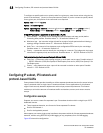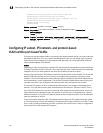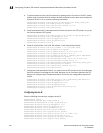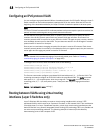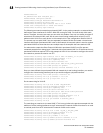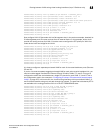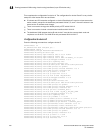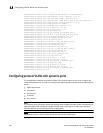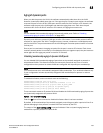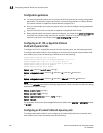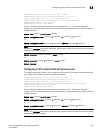
460 PowerConnect B-Series FCX Configuration Guide
53-1002266-01
Routing between VLANs using virtual routing interfaces (Layer 3 Switches only)
13
PowerConnect>en
No password has been assigned yet...
PowerConnect# configure terminal
PowerConnect(config)# hostname PowerConnect-A
PowerConnect-A(config)# router ospf
PowerConnect-A(config-ospf-router)# area 0.0.0.0 normal
Please save configuration to flash and reboot.
PowerConnect-A(config-ospf-router)#
The following commands create the port-based VLAN 2. In the previous example, an external device
defined the router interfaces for VLAN 2. With ISR, routing for VLAN 2 is done locally within each
device. Therefore, there are two ways you can solve this problem. One way is to create a unique IP
subnet and IPX network VLAN, each with its own virtual routing interface and unique IP or IPX
address within VLAN 2 on each device. In this example, this is the configuration used for VLAN 3.
The second way is to split VLAN 2 into two separate port-based VLANs and create a virtual router
interface within each port-based VLAN. Later in this example, this second option is used to create a
port-based VLAN 8 to show that there are multiple ways to accomplish the same task with ISR.
You also need to create the Other-Protocol VLAN within port-based VLAN 2 and 8 to prevent
unwanted protocols from being Layer 2 switched within port-based VLAN 2 or 8. Note that the only
port-based VLAN that requires STP in this example is VLAN 4. You will need to configure the rest of
the network to prevent the need to run STP.
PowerConnect-A(config-ospf-router)# vlan 2 name IP-Subnet_1.1.2.0/24
PowerConnect-A(config-vlan-2)# untagged ethernet 1 to 4
PowerConnect-A(config-vlan-2)# no spanning-tree
PowerConnect-A(config-vlan-2)# router-interface ve1
PowerConnect-A(config-vlan-2)# other-proto name block_other_protocols
PowerConnect-A(config-vlan-other-proto)# no dynamic
PowerConnect-A(config-vlan-other-proto)# exclude ethernet 1 to 4
Once you have defined the port-based VLAN and created the virtual routing interface, you need to
configure the virtual routing interface just as you would configure a physical interface.
PowerConnect-A(config-vlan-other-proto)# interface ve1
PowerConnect-A(config-vif-1)# ip address 1.1.2.1/24
PowerConnect-A(config-vif-1)# ip ospf area 0.0.0.0
Do the same thing for VLAN 8.
PowerConnect-A(config-vif-1)# vlan 8 name IPX_Network2
PowerConnect-A(config-vlan-8)# untagged ethernet 5 to 8
PowerConnect-A(config-vlan-8)# no spanning-tree
PowerConnect-A(config-vlan-8)# router-interface ve 2
PowerConnect-A(config-vlan-8)# other-proto name block-other-protocols
PowerConnect-A(config-vlan-other-proto)# no dynamic
PowerConnect-A(config-vlan-other-proto)# exclude ethernet 5 to 8
PowerConnect-A(config-vlan-other-proto)# interface ve2
PowerConnect-A(config-vif-2)# ipx network 2 ethernet_802.3
PowerConnect-A(config-vif-2)#
The next thing you need to do is create VLAN 3. This is very similar to the previous example with the
addition of virtual routing interfaces to the IP subnet and IPX network VLANs. Also there is no need
to exclude ports from the IP subnet and IPX network VLANs on the router.
PowerConnect-A(config-vif-2)# vlan 3 name IP_Sub_&_IPX_Net_VLAN
PowerConnect-A(config-vlan-3)# untagged ethernet 9 to 16
PowerConnect-A(config-vlan-3)# no spanning-tree
PowerConnect-A(config-vlan-3)# ip-subnet 1.1.1.0/24
PowerConnect-A(config-vlan-ip-subnet)# static ethernet 9 to 12
PowerConnect-A(config-vlan-ip-subnet)# router-interface ve3



